Investigation of Electric Field Tunable Optical and Electrical Characteristics of Zigzag and Armchair Graphene Nanoribbons: An Ab Initio Approach
Abstract
:1. Introduction
2. Materials and Methods
3. Results and Discussion
3.1. Electric-Field-Dependent Optical Characteristics of the GNR Samples
3.2. Electric-Field-Dependent Electrical Transmission Characteristics of the GNR Samples
4. Conclusions
Supplementary Materials
Author Contributions
Funding
Data Availability Statement
Conflicts of Interest
References
- Gusynin, V.; Sharapov, S.; Carbotte, J. Magneto-optical conductivity in graphene. J. Phys. Condens. Matter 2006, 19, 026222. [Google Scholar] [CrossRef]
- Falkovsky, L.; Pershoguba, S. Optical far-infrared properties of a graphene monolayer and multilayer. Phys. Rev. B—Condens. Matter Mater. Phys. 2007, 76, 153410. [Google Scholar] [CrossRef]
- Falkovsky, L.A. Optical properties of graphene. J. Phys. Conf. Ser. 2008, 129, 012004. [Google Scholar] [CrossRef]
- Mak, K.F.; Sfeir, M.Y.; Wu, Y.; Lui, C.H.; Misewich, J.A.; Heinz, T.F. Measurement of the optical conductivity of graphene. Phys. Rev. Lett. 2008, 101, 196405. [Google Scholar] [CrossRef]
- Nair, R.R.; Blake, P.; Grigorenko, A.N.; Novoselov, K.S.; Booth, T.J.; Stauber, T.; Peres, N.M.; Geim, A.K. Fine structure constant defines visual transparency of graphene. Science 2008, 320, 1308. [Google Scholar] [CrossRef] [PubMed]
- Sheehy, D.E.; Schmalian, J. Optical transparency of graphene as determined by the fine-structure constant. Phys. Rev. B—Condens. Matter Mater. Phys. 2009, 80, 193411. [Google Scholar] [CrossRef]
- Stauber, T.; Peres, N.M.; Geim, A.K. Optical conductivity of graphene in the visible region of the spectrum. Phys. Rev. B—Condens. Matter Mater. Phys. 2008, 78, 085432. [Google Scholar] [CrossRef]
- Wang, F.; Zhang, Y.; Tian, C.; Girit, C.; Zettl, A.; Crommie, M.; Shen, Y.R. Gate-variable optical transitions in graphene. Science 2008, 320, 206–209. [Google Scholar] [CrossRef] [PubMed]
- Bruna, M.; Borini, S. Optical constants of graphene layers in the visible range. Appl. Phys. Lett. 2009, 94, 031901. [Google Scholar] [CrossRef]
- Hendry, E.; Hale, P.J.; Moger, J.; Savchenko, A.; Mikhailov, S.A. Coherent nonlinear optical response of graphene. Phys. Rev. Lett. 2010, 105, 097401. [Google Scholar] [CrossRef]
- Skulason, H.; Gaskell, P.; Szkopek, T. Optical reflection and transmission properties of exfoliated graphite from a graphene monolayer to several hundred graphene layers. Nanotechnology 2010, 21, 295709. [Google Scholar] [CrossRef] [PubMed]
- Lee, C.; Kim, J.Y.; Bae, S.; Kim, K.S.; Hong, B.H.; Choi, E. Optical response of large scale single layer graphene. Appl. Phys. Lett. 2011, 98, 071905. [Google Scholar] [CrossRef]
- Zhou, Y.; Wu, M.-W. Optical response of graphene under intense terahertz fields. Phys. Rev. B—Condens. Matter Mater. Phys. 2011, 83, 245436. [Google Scholar] [CrossRef]
- Mak, K.F.; Ju, L.; Wang, F.; Heinz, T.F. Optical spectroscopy of graphene: From the far infrared to the ultraviolet. Solid State Commun. 2012, 152, 1341–1349. [Google Scholar] [CrossRef]
- Malard, L.M.; Mak, K.F.; Neto, A.C.; Peres, N.; Heinz, T.F. Observation of intra-and inter-band transitions in the transient optical response of graphene. New J. Phys. 2013, 15, 015009. [Google Scholar] [CrossRef]
- Cheng, J.-L.; Vermeulen, N.; Sipe, J. Third order optical nonlinearity of graphene. New J. Phys. 2014, 16, 053014. [Google Scholar] [CrossRef]
- Rani, P.; Dubey, G.S.; Jindal, V. DFT study of optical properties of pure and doped graphene. Phys. E Low-Dimens. Syst. Nanostructures 2014, 62, 28–35. [Google Scholar] [CrossRef]
- Zhu, S.-E.; Yuan, S.; Janssen, G. Optical transmittance of multilayer graphene. Europhys. Lett. 2014, 108, 17007. [Google Scholar] [CrossRef]
- Demetriou, G.; Bookey, H.T.; Biancalana, F.; Abraham, E.; Wang, Y.; Ji, W.; Kar, A.K. Nonlinear optical properties of multilayer graphene in the infrared. Opt. Express 2016, 24, 13033–13043. [Google Scholar] [CrossRef]
- Dremetsika, E.; Dlubak, B.; Gorza, S.-P.; Ciret, C.; Martin, M.-B.; Hofmann, S.; Seneor, P.; Dolfi, D.; Massar, S.; Emplit, P. Measuring the nonlinear refractive index of graphene using the optical Kerr effect method. Opt. Lett. 2016, 41, 3281–3284. [Google Scholar] [CrossRef]
- Li, W.; Cheng, G.; Liang, Y.; Tian, B.; Liang, X.; Peng, L.; Walker, A.H.; Gundlach, D.J.; Nguyen, N.V. Broadband optical properties of graphene by spectroscopic ellipsometry. Carbon 2016, 99, 348–353. [Google Scholar] [CrossRef]
- Semnani, B.; Majedi, A.H.; Safavi-Naeini, S. Nonlinear quantum optical properties of graphene. J. Opt. 2016, 18, 035402. [Google Scholar] [CrossRef]
- Baudisch, M.; Marini, A.; Cox, J.D.; Zhu, T.; Silva, F.; Teichmann, S.; Massicotte, M.; Koppens, F.; Levitov, L.S.; García de Abajo, F.J. Ultrafast nonlinear optical response of Dirac fermions in graphene. Nat. Commun. 2018, 9, 1018. [Google Scholar] [CrossRef]
- Shih, P.-H.; Do, T.-N.; Gumbs, G.; Lin, M.-F. Electronic and optical properties of doped graphene. Phys. E Low-Dimens. Syst. Nanostructures 2020, 118, 113894. [Google Scholar] [CrossRef]
- Fu, M.; Ye, Y.; Niu, Y.; Guo, S.; Wang, Z.; Liu, X. Graphene-Based Tunable Dual-Frequency Terahertz Sensor. Nanomaterials 2024, 14, 378. [Google Scholar] [CrossRef] [PubMed]
- Yang, L.; Cohen, M.L.; Louie, S.G. Excitonic effects in the optical spectra of graphene nanoribbons. Nano Lett. 2007, 7, 3112–3115. [Google Scholar] [CrossRef]
- Liao, W.; Zhou, G.; Xi, F. Optical properties for armchair-edge graphene nanoribbons. J. Appl. Phys. 2008, 104, 126105. [Google Scholar] [CrossRef]
- Wright, A.; Cao, J.; Zhang, C. Enhanced optical conductivity of bilayer graphene nanoribbons in the terahertz regime. Phys. Rev. Lett. 2009, 103, 207401. [Google Scholar] [CrossRef]
- Wu, J.-Y.; Chen, L.-H.; Li, T.-S.; Lin, M.-F. Optical properties of graphene nanoribbon in a spatially modulated magnetic field. Appl. Phys. Lett. 2010, 97, 031114. [Google Scholar] [CrossRef]
- Ahmadi, E.; Asgari, A. Theoretical calculation of optical absorption spectrum for armchair graphene nanoribbon. Procedia Eng. 2011, 8, 25–29. [Google Scholar] [CrossRef]
- Mohammadzadeh, L.; Asgari, A.; Shojaei, S.; Ahmadi, E. Theoretical calculation of excitonic binding energies and optical absorption spectra for Armchair graphene nanoribbons. Eur. Phys. J. B 2011, 84, 249–253. [Google Scholar] [CrossRef]
- Sasaki, K.-i.; Kato, K.; Tokura, Y.; Oguri, K.; Sogawa, T. Theory of optical transitions in graphene nanoribbons. Phys. Rev. B—Condens. Matter Mater. Phys. 2011, 84, 085458. [Google Scholar] [CrossRef]
- Li, T.; Lin, M.; Chang, S. Modulation of curved graphene nanoribbon optical absorption spectra by an electric field. Philos. Mag. 2012, 92, 4376–4388. [Google Scholar] [CrossRef]
- Alaei, R.; Sheikhi, M. Optical absorption of graphene nanoribbon in transverse and modulated longitudinal electric field. Fuller. Nanotub. Carbon Nanostructures 2013, 21, 183–197. [Google Scholar] [CrossRef]
- Denk, R.; Hohage, M.; Zeppenfeld, P.; Cai, J.; Pignedoli, C.A.; Söde, H.; Fasel, R.; Feng, X.; Müllen, K.; Wang, S. Exciton-dominated optical response of ultra-narrow graphene nanoribbons. Nat. Commun. 2014, 5, 4253. [Google Scholar] [CrossRef]
- Raji, A.-R.O.; Salters, S.; Samuel, E.L.; Zhu, Y.; Volman, V.; Tour, J.M. Functionalized graphene nanoribbon films as a radiofrequency and optically transparent material. ACS Appl. Mater. Interfaces 2014, 6, 16661–16668. [Google Scholar] [CrossRef]
- Asadpour, M.; Jafari, M.; Asadpour, M.; Jafari, M. Optical properties of two-dimensional zigzag and armchair graphyne nanoribbon semiconductor. Spectrochim. Acta Part A Mol. Biomol. Spectrosc. 2015, 139, 380–384. [Google Scholar] [CrossRef]
- Berahman, M.; Asad, M.; Sanaee, M.; Sheikhi, M. Optical properties of chiral graphene nanoribbons: A first principle study. Opt. Quantum Electron. 2015, 47, 3289–3300. [Google Scholar] [CrossRef]
- Hassan, A.; Hossain, M.; Sobhan, S.A.; Haq, M.R.; Siddiquee, T.A. Armchair graphene nanoribbon photonics. In Proceedings of the 2015 Science and Information Conference (SAI), London, UK, 28–30 July 2015; pp. 1108–1112. [Google Scholar] [CrossRef]
- Velizhanin, K.A. Geometric universality of plasmon modes in graphene nanoribbon arrays. Phys. Rev. B 2015, 91, 125429. [Google Scholar] [CrossRef]
- Chen, Z.; Wang, H.I.; Teyssandier, J.; Mali, K.S.; Dumslaff, T.; Ivanov, I.; Zhang, W.; Ruffieux, P.; Fasel, R.; Räder, H.J. Chemical vapor deposition synthesis and terahertz photoconductivity of low-band-gap N= 9 armchair graphene nanoribbons. J. Am. Chem. Soc. 2017, 139, 3635–3638. [Google Scholar] [CrossRef]
- Zhou, R.; Yang, S.; Liu, D.; Cao, G. Confined surface plasmon of fundamental wave and second harmonic waves in graphene nanoribbon arrays. Opt. Express 2017, 25, 31478–31491. [Google Scholar] [CrossRef] [PubMed]
- Rezania, H.; Satar, A.K. Magnetic field effects on optical conductivity of doped armchair graphene nanoribbon. J. Supercond. Nov. Magn. 2019, 32, 205–211. [Google Scholar] [CrossRef]
- Hasani, M.; Chegell, R. Electronic and optical properties of the Graphene and Boron Nitride nanoribbons in presence of the electric field. J. Optoelectron. Nanostructures 2020, 5, 49–64. [Google Scholar]
- Jabbar, M.L.; Kadhim, K.J. Linear & nonlinear optical properties of undoped & doped graphene nanoribbon via TD-DFT study. In Proceedings of the AIP Conference Proceedings, Coimbatore, India, 17–18 July 2020. [Google Scholar] [CrossRef]
- Uryu, S. Excitons and plasmons of graphene nanoribbons in infrared frequencies in an effective-mass approximation. Phys. Rev. B 2020, 102, 155409. [Google Scholar] [CrossRef]
- Klimenko, O.; Schuler, S.; Muratov, A.; Semenenko, V.; Gorbachev, E.; Mueller, T.; Perebeinos, V. Tunable graphene plasmons in nanoribbon arrays: The role of interactions. Opt. Mater. Express 2021, 11, 1390–1400. [Google Scholar] [CrossRef]
- Sheridan, E.; Li, G.; Sarker, M.; Hao, S.; Eom, K.-T.; Eom, C.-B.; Sinitskii, A.; Irvin, P.; Levy, J. Gate-tunable optical extinction of graphene nanoribbon nanoclusters. APL Mater. 2021, 9, 071101. [Google Scholar] [CrossRef]
- Zhang, L.; Chen, J.; Zhang, L.; Xu, F.; Xiao, L.; Jia, S. Gate controllable optical spin current generation in zigzag graphene nanoribbon. Carbon 2021, 173, 565–571. [Google Scholar] [CrossRef]
- Ge, Y.; Fisher, T.S. First-principles calculations of the optical response of single-layer and bilayer armchair graphene nanoribbons. Front. Nanotechnol. 2022, 4, 999292. [Google Scholar] [CrossRef]
- Jiang, S.; Neuman, T.; Boeglin, A.; Scheurer, F.; Schull, G. Topologically localized excitons in single graphene nanoribbons. Science 2023, 379, 1049–1054. [Google Scholar] [CrossRef]
- Nguyen, L.T.D.; Ngo, V.-C.; Thai, T.-L.; Phan, D.-T.-N.; Nguyen, T.-A.-D.; Tran, V.-T.T.; Vu, T.-T.; Phan, T.-K.-L. Correlation between energy band transition and optical absorption spectrum in bilayer armchair graphene nanoribbons. J. Phys. Condens. Matter 2023, 35, 385301. [Google Scholar] [CrossRef]
- Zhang, N.; Yang, Z.; Zhang, Z.; Wang, J. Relationship Between Stress Modulated Metallicity and Plasmon in Graphene Nanoribbons. ChemPhysChem 2023, 24, e202300348. [Google Scholar] [CrossRef] [PubMed]
- Liu, Q.; Feng, N.; Zou, Y.; Fan, C.; Wang, J. Exploring the impact of stress on the electronic structure and optical properties of graphdiyne nanoribbons for advanced optoelectronic applications. Sci. Rep. 2024, 14, 6051. [Google Scholar] [CrossRef]
- Rezania, H.; Kakavandi, T. Optical absorption rate in doped armchair graphene nanoribbon due to impurity atoms effects. Opt. Quantum Electron. 2024, 56, 982. [Google Scholar] [CrossRef]
- Zeng, C.; Lu, H.; Mao, D.; Du, Y.; Hua, H.; Zhao, W.; Zhao, J. Graphene-empowered dynamic metasurfaces and metadevices. Opto-Electron. Adv. 2022, 5, 200098. [Google Scholar] [CrossRef]
- Jiang, B.; Hou, Y.; Wu, J.; Ma, Y.; Gan, X.; Zhao, J. In-fiber photoelectric device based on graphene-coated tilted fiber grating. Opto-Electron. Sci. 2023, 2, 230012. [Google Scholar] [CrossRef]
- Li, W.; Liu, M.; Cheng, S.; Zhang, H.; Yang, W.; Yi, Z.; Zeng, Q.; Tang, B.; Ahmad, S.; Sun, T. Polarization independent tunable bandwidth absorber based on single-layer graphene. Diam. Relat. Mater. 2024, 142, 110793. [Google Scholar] [CrossRef]
- Wakabayashi, K. Electronic transport properties of nanographite ribbon junctions. Phys. Rev. B 2001, 64, 125428. [Google Scholar] [CrossRef]
- Munoz-Rojas, F.; Jacob, D.; Fernández-Rossier, J.; Palacios, J. Coherent transport in graphene nanoconstrictions. Phys. Rev. B—Condens. Matter Mater. Phys. 2006, 74, 195417. [Google Scholar] [CrossRef]
- Peres, N.; Castro Neto, A.; Guinea, F. Conductance quantization in mesoscopic graphene. Phys. Rev. B—Condens. Matter Mater. Phys. 2006, 73, 195411. [Google Scholar] [CrossRef]
- Gunlycke, D.; Lawler, H.; White, C. Room-temperature ballistic transport in narrow graphene strips. Phys. Rev. B—Condens. Matter Mater. Phys. 2007, 75, 085418. [Google Scholar] [CrossRef]
- Li, Z.; Qian, H.; Wu, J.; Gu, B.-L.; Duan, W. Role of symmetry in the transport properties of graphene nanoribbons under bias. Phys. Rev. Lett. 2008, 100, 206802. [Google Scholar] [CrossRef] [PubMed]
- Kimouche, A.; Ervasti, M.M.; Drost, R.; Halonen, S.; Harju, A.; Joensuu, P.M.; Sainio, J.; Liljeroth, P. Ultra-narrow metallic armchair graphene nanoribbons. Nat. Commun. 2015, 6, 10177. [Google Scholar] [CrossRef]
- López-Urías, F.; Ortiz-Medina, J. Unconventional metallicity in graphene nanoribbons with armchair edges. Adv. Theory Simul. 2022, 5, 2100392. [Google Scholar] [CrossRef]
- Zakharov, M. Performance of numerical atom-centered basis sets in the ground-state correlated calculations of noncovalent interactions: Water and methane dimer cases. Int. J. Quantum Chem. 2013, 113, 1899–1918. [Google Scholar] [CrossRef]
- Blum, V.; Gehrke, R.; Hanke, F.; Havu, P.; Havu, V.; Ren, X.; Reuter, K.; Scheffler, M. Ab initio molecular simulations with numeric atom-centered orbitals. Comput. Phys. Commun. 2009, 180, 2175–2196. [Google Scholar] [CrossRef]
- Head, J.D.; Zerner, M.C. A Broyden—Fletcher—Goldfarb—Shanno optimization procedure for molecular geometries. Chem. Phys. Lett. 1985, 122, 264–270. [Google Scholar] [CrossRef]
- Wang, Z.F.; Li, Q.; Zheng, H.; Ren, H.; Su, H.; Shi, Q.W.; Chen, J. Tuning the electronic structure of graphene nanoribbons through chemical edge modification: A theoretical study. Phys. Rev. B 2007, 75, 113406. [Google Scholar] [CrossRef]
- Vandescuren, M.; Hermet, P.; Meunier, V.; Henrard, L.; Lambin, P. Theoretical study of the vibrational edge modes in graphene nanoribbons. Phys. Rev. B 2008, 78, 195401. [Google Scholar] [CrossRef]
- Li, Y.; Zhou, Z.; Shen, P.; Chen, Z. Spin gapless semiconductor− metal− half-metal properties in nitrogen-doped zigzag graphene nanoribbons. ACS Nano 2009, 3, 1952–1958. [Google Scholar] [CrossRef]
- Tang, S.; Zhang, S. Structural and electronic properties of hybrid fluorographene–graphene nanoribbons: Insight from first-principles calculations. J. Phys. Chem. C 2011, 115, 16644–16651. [Google Scholar] [CrossRef]
- Zaminpayma, E.; Nayebi, P.; Emami-Razavi, M. Electronic properties of the interface between metallic doped zigzag graphene and pristine graphene nanoribbons. J. Inorg. Organomet. Polym. Mater. 2020, 30, 3694–3701. [Google Scholar] [CrossRef]
- Köstler, H.; Schmid, R.; Rüde, U.; Scheit, C. A parallel multigrid accelerated Poisson solver for ab initio molecular dynamics applications. Comput. Vis. Sci. 2008, 11, 115–122. [Google Scholar] [CrossRef]
- Smidstrup, S.; Markussen, T.; Vancraeyveld, P.; Wellendorff, J.; Schneider, J.; Gunst, T.; Verstichel, B.; Stradi, D.; Khomyakov, P.A.; Vej-Hansen, U.G. QuantumATK: An integrated platform of electronic and atomic-scale modelling tools. J. Phys. Condens. Matter 2019, 32, 015901. [Google Scholar] [CrossRef] [PubMed]
- Harrison, W.A. Solid State Theory; Dover Publications: Mineola, NY, USA, 1980; p. 576. Available online: https://store.doverpublications.com/products/9780486639482 (accessed on 12 July 2024).
- Quantumwise ATK; Quantumwise AS: Copenhagen, Denmark. 2014. Available online: https://www.quantumwise.com (accessed on 12 July 2014).
- Deng, S.; Li, L.; Zhang, Y. Strain Modulated Electronic, Mechanical, and Optical Properties of the Monolayer PdS2, PdSe2, and PtSe2 for Tunable Devices. ACS Appl. Nano Mater. 2018, 1, 1932–1939. [Google Scholar] [CrossRef]
- Khan, M.S.; Srivastava, A. Diameter Dependent Electronic, Optical and Transport Properties of CdSe Nanowire: Ab-Initio Study. Semiconductors 2019, 53, 1759–1768. [Google Scholar] [CrossRef]
- Desjarlais, M.P. Density functional calculations of the reflectivity of shocked xenon with ionization based gap corrections. Contrib. Plasma Phys. 2005, 45, 300–304. [Google Scholar] [CrossRef]
- Martin, R.M. Electronic Structure: Basic Theory and Practical Methods, 2nd ed.; Cambridge University Press: Cambridge, UK, 2020; p. 650. Available online: https://www.cambridge.org/tr/universitypress/subjects/physics/condensed-matter-physics-nanoscience-and-mesoscopic-physics/electronic-structure-basic-theory-and-practical-methods-2nd-edition?format=HB&isbn=9781108429900 (accessed on 10 July 2024).
- Datta, S. Quantum Transport: Atom to Transistor; Cambridge University Press: Cambridge, UK, 2013; Available online: https://www.cambridge.org/tr/universitypress/subjects/engineering/electronic-optoelectronic-devices-and-nanotechnology/quantum-transport-atom-transistor?format=PB (accessed on 10 July 2024).
- Hou, S.; Qian, Z.; Li, R. Electron transport in molecular electronic devices. In Annual Review of Nano Research; World Scientific: Toh Tuck Link, Singapore, 2006; pp. 255–294. [Google Scholar] [CrossRef]
- Luisier, M. Atomistic simulation of transport phenomena in nanoelectronic devices. Chem. Soc. Rev. 2014, 43, 4357–4367. [Google Scholar] [CrossRef]
- Büttiker, M.; Imry, Y.; Landauer, R.; Pinhas, S. Generalized many-channel conductance formula with application to small rings. Phys. Rev. B 1985, 31, 6207. [Google Scholar] [CrossRef]
- Landauer, R. Spatial variation of currents and fields due to localized scatterers in metallic conduction. IBM J. Res. Dev. 1957, 1, 223–231. [Google Scholar] [CrossRef]
- Landauer, R. Electrical resistance of disordered one-dimensional lattices. Philos. Mag. 1970, 21, 863–867. [Google Scholar] [CrossRef]
- Wang, X.; Chen, Y.P.; Nolte, D.D. Strong anomalous optical dispersion of graphene: Complex refractive index measured by Picometrology. Opt. Express 2008, 16, 22105–22112. [Google Scholar] [CrossRef] [PubMed]
- Cheon, S.; Kihm, K.D. Complex refractive index (RI) of graphene. In Handbook of Graphene Set; Scrivener Publishing: Beverly, MA, USA, 2019; pp. 389–412. [Google Scholar] [CrossRef]
- Pistore, V.; Balci, O.; Zhang, J.; Schinde, S.M.; Meersha, A.; Ferrari, A.C.; Vitiello, M.S. Mapping the complex refractive index of single layer graphene on semiconductor or polymeric substrates at terahertz frequencies. 2D Mater. 2022, 9, 025018. [Google Scholar] [CrossRef]
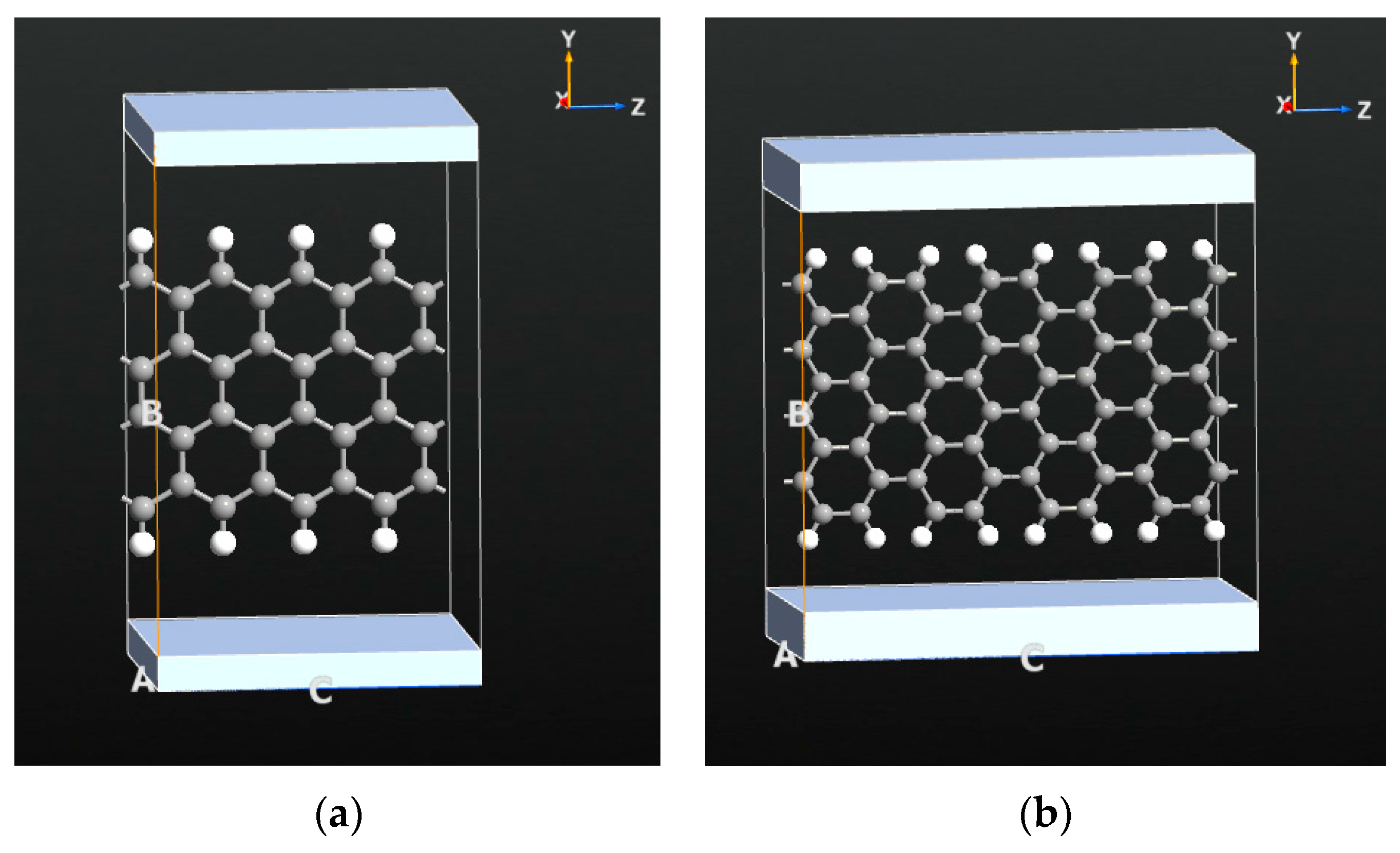
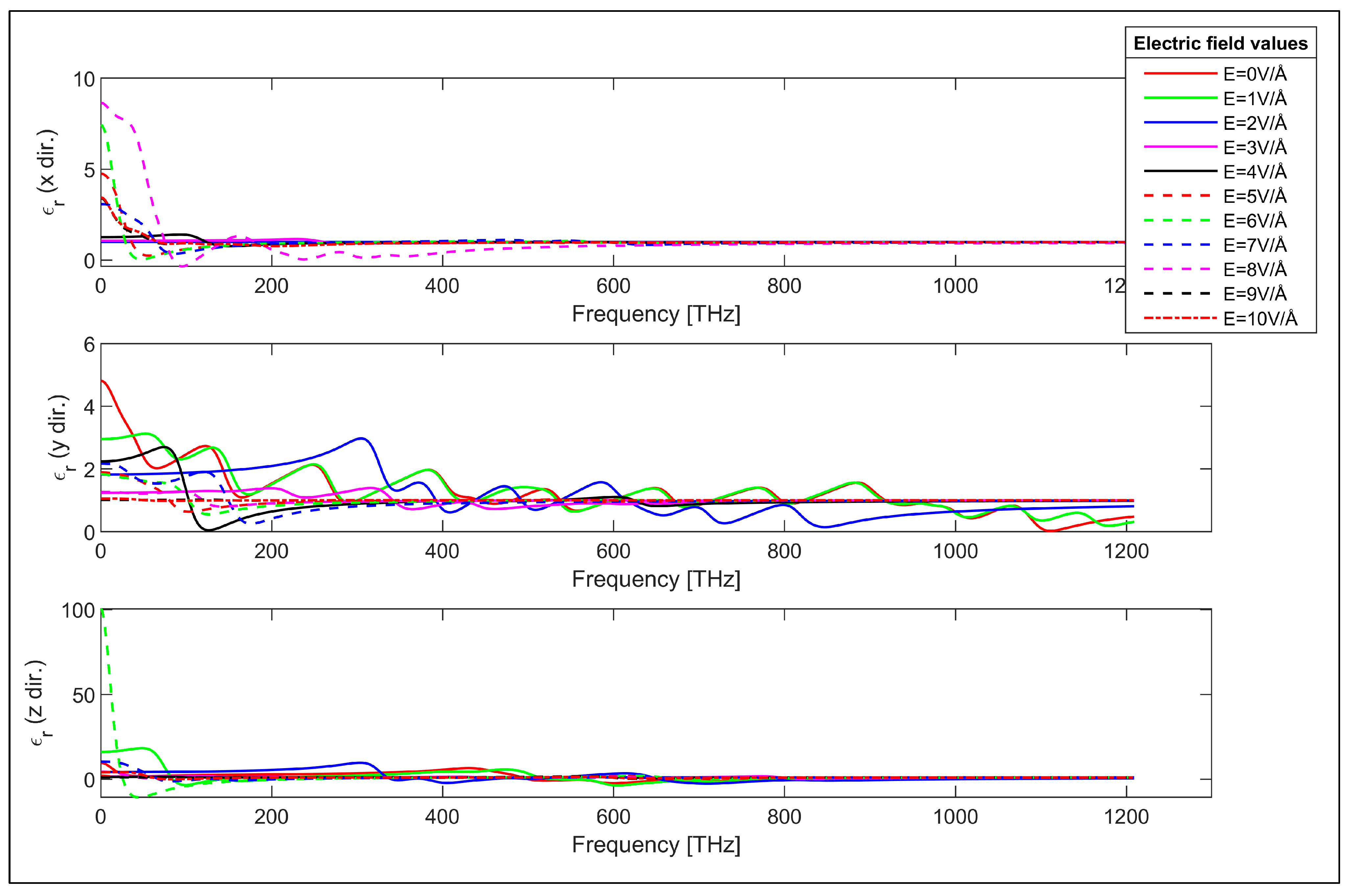
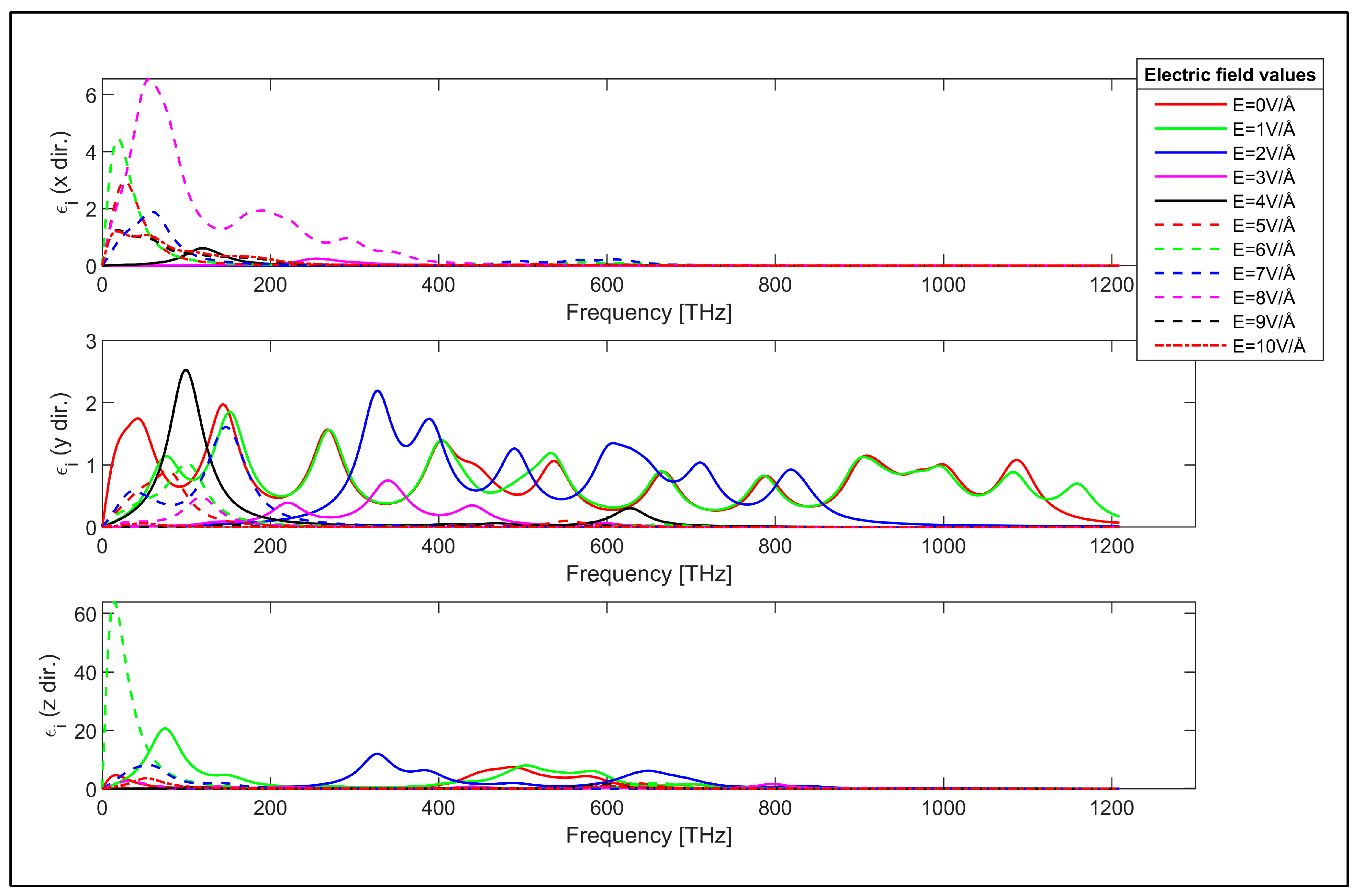
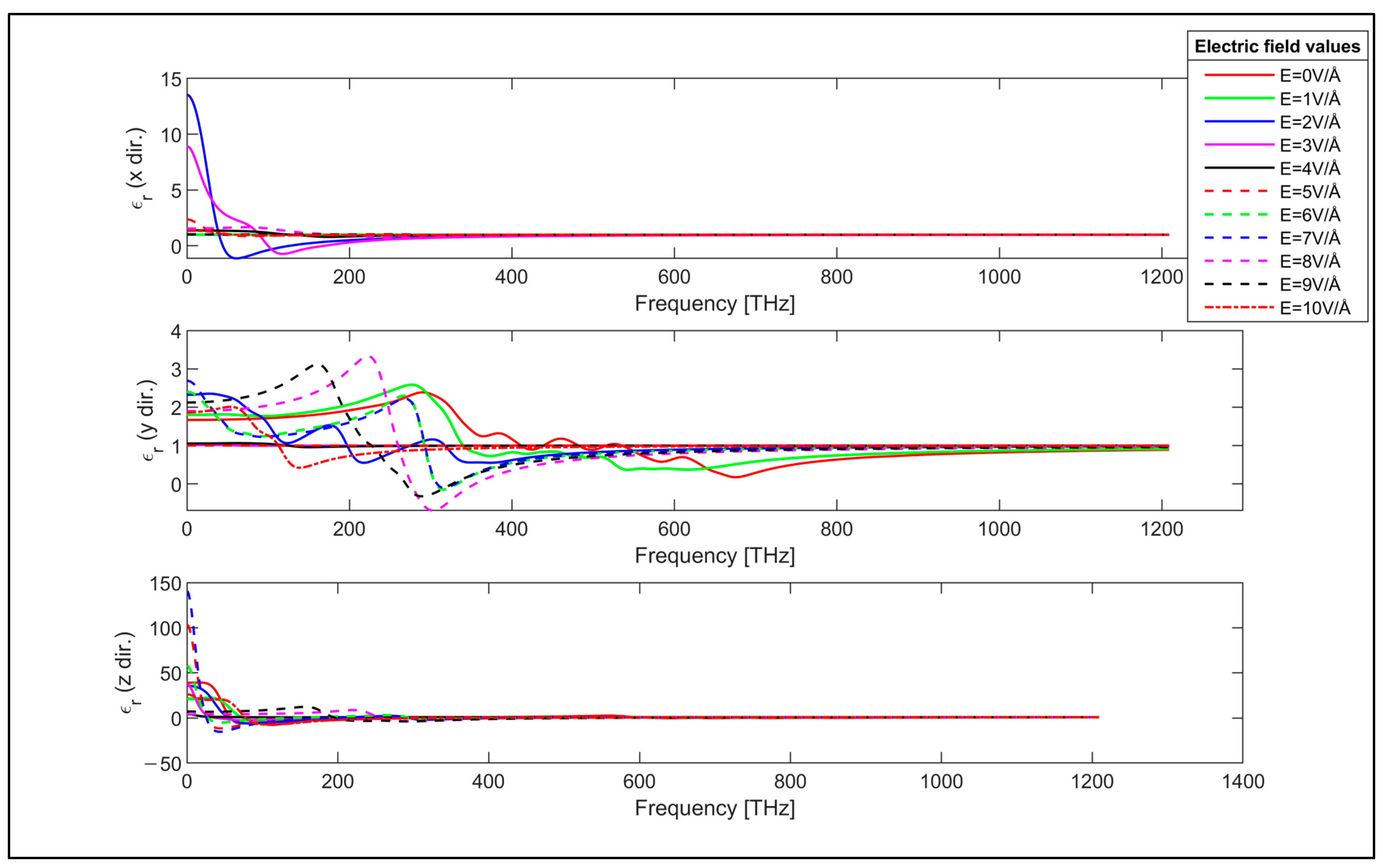
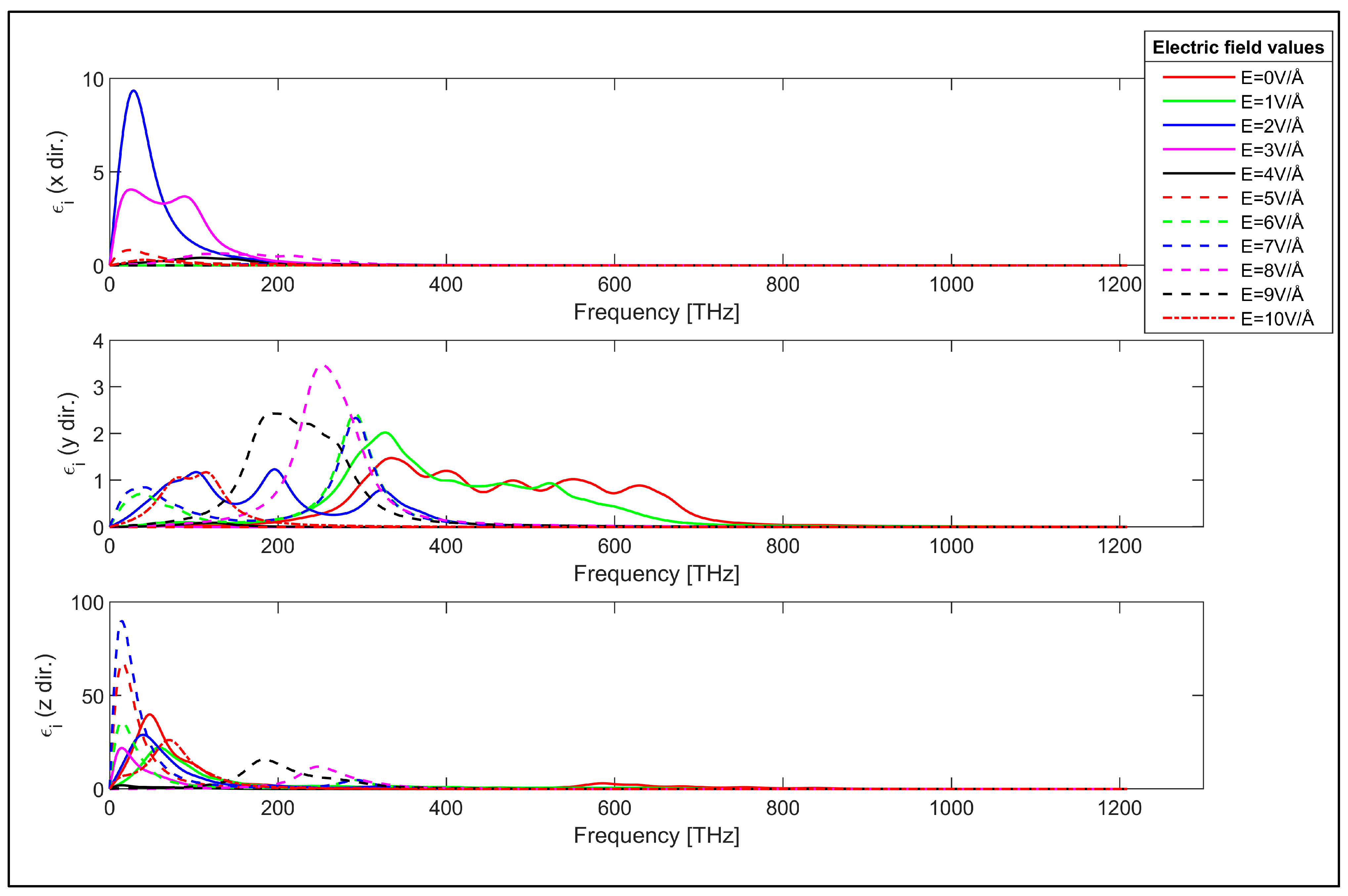
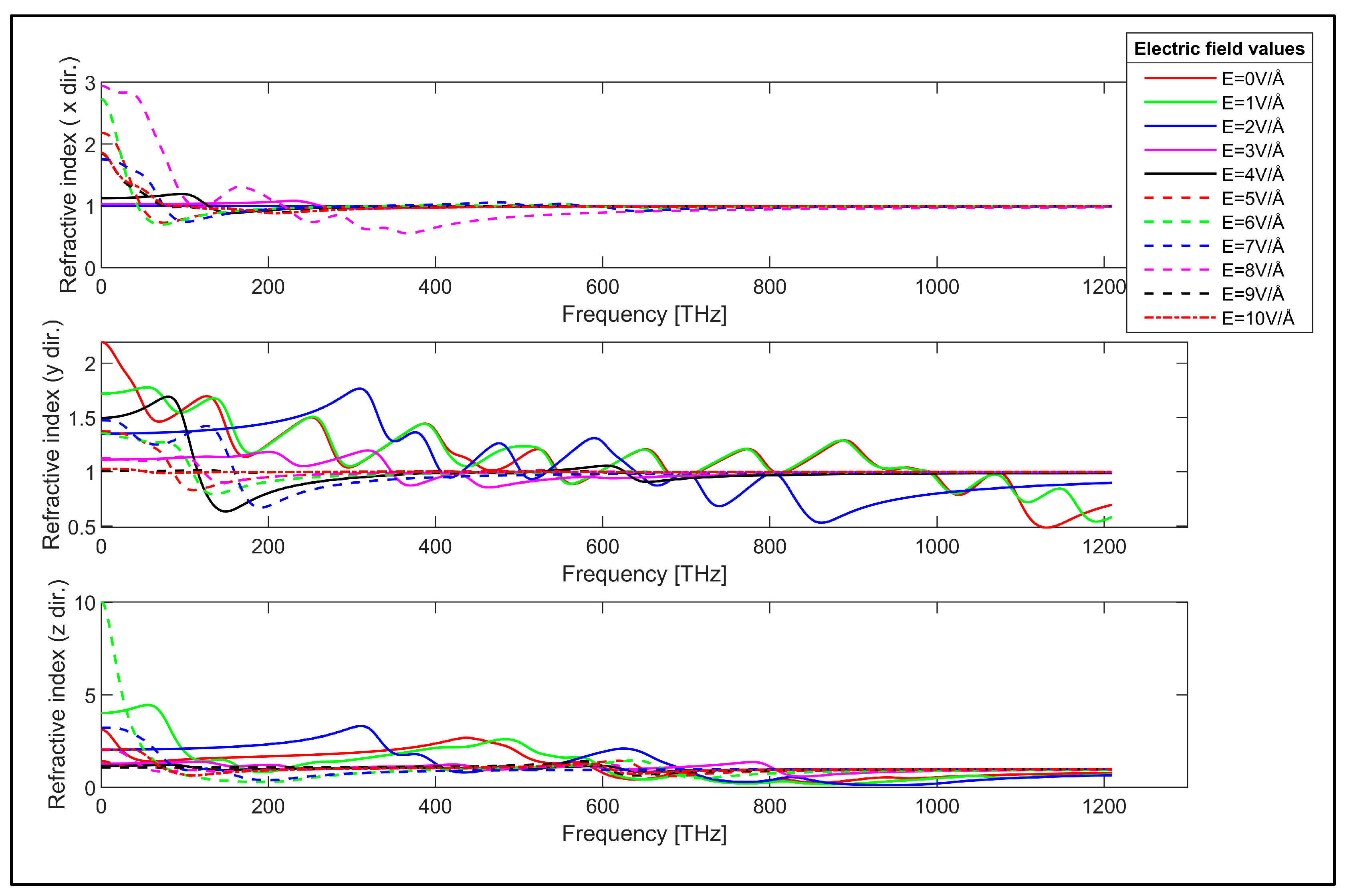
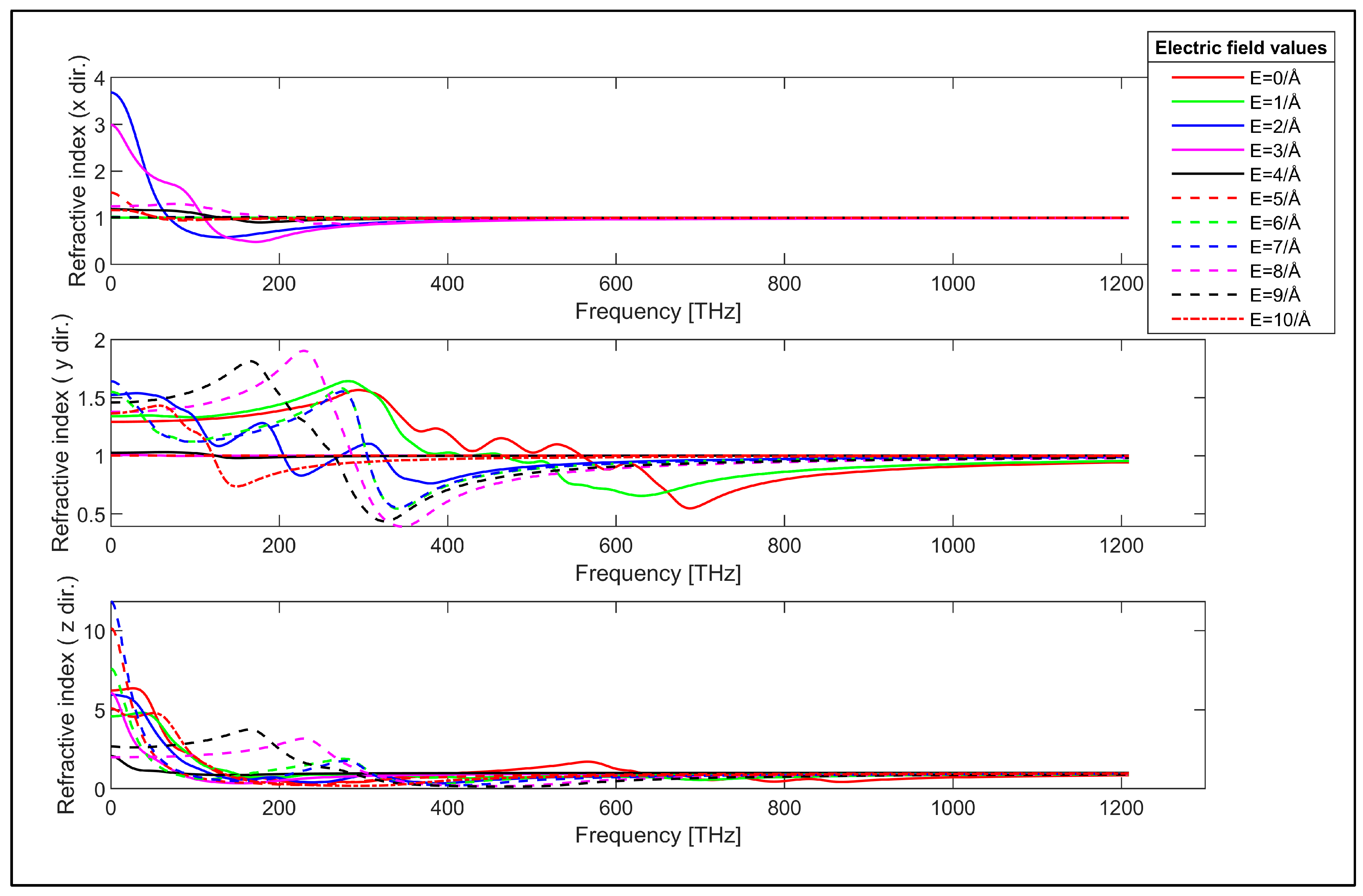
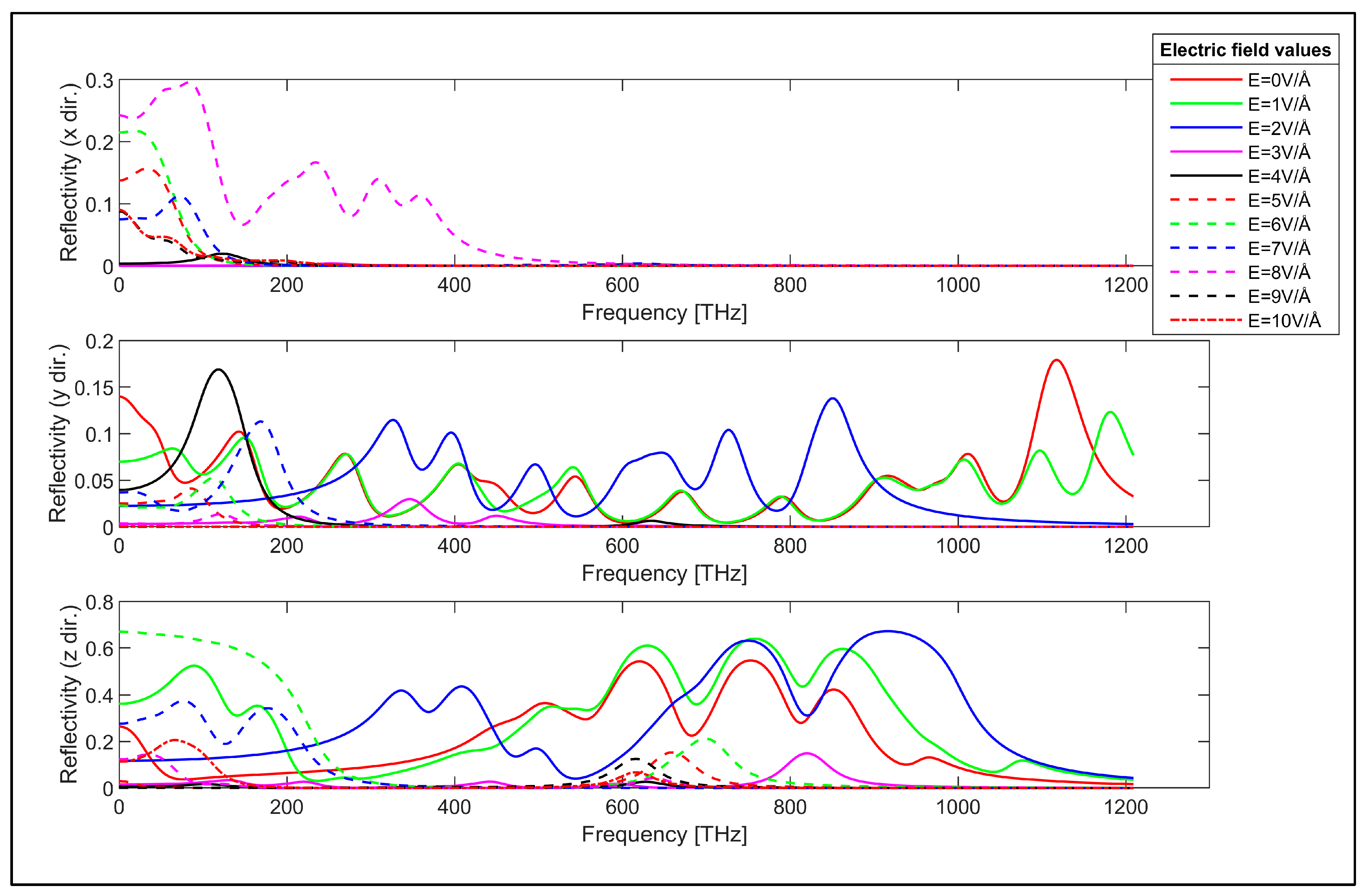



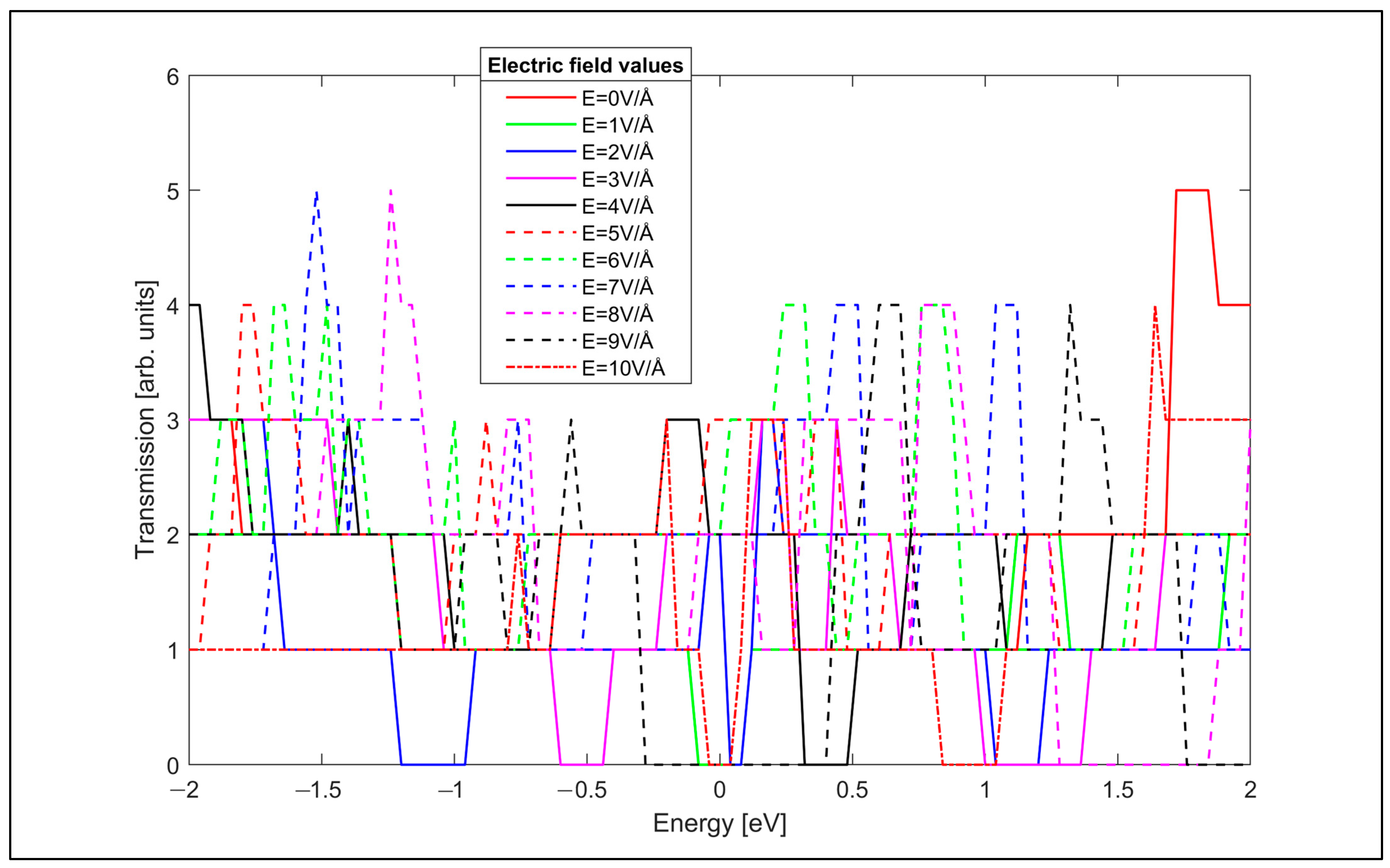
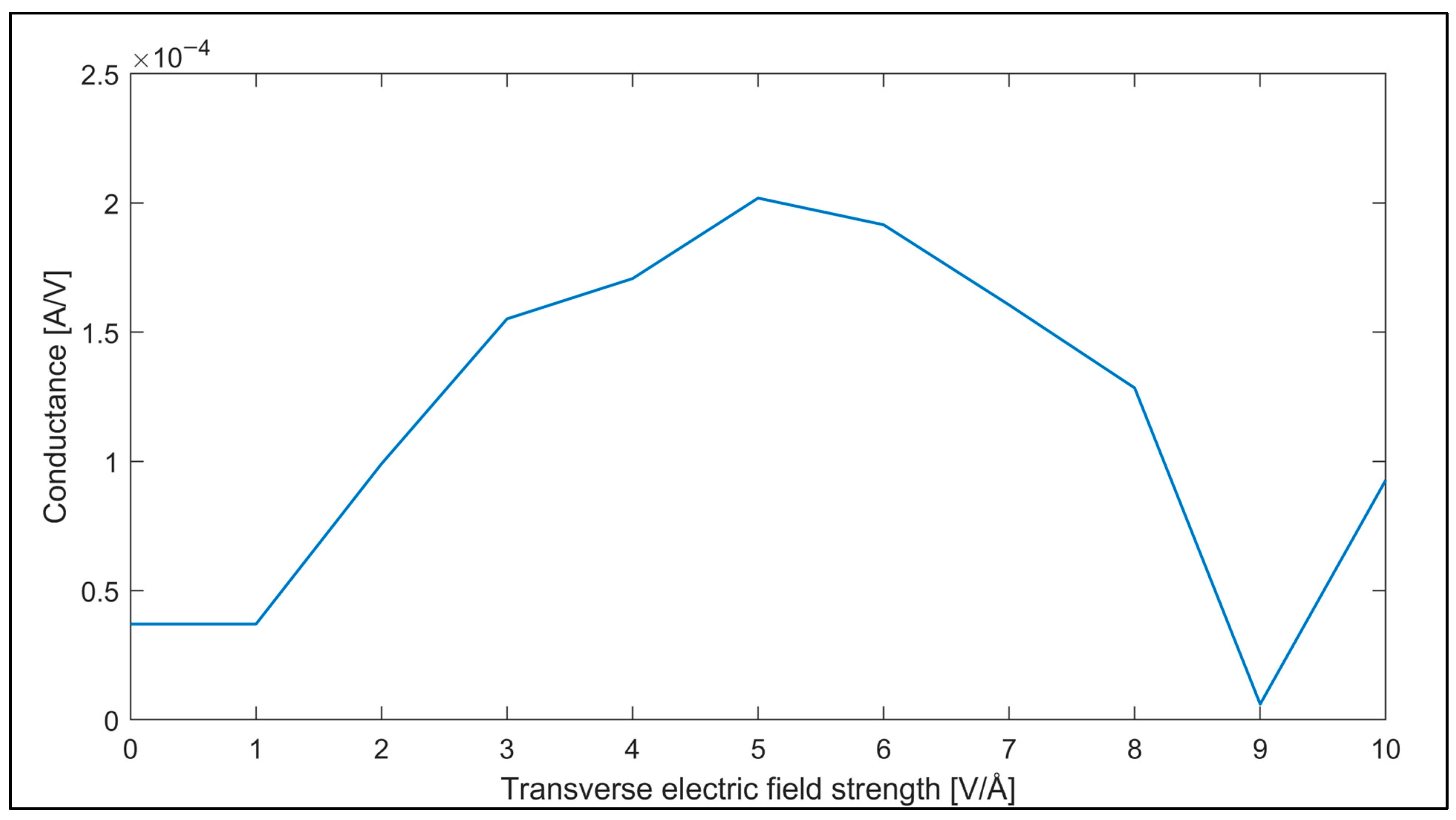
Disclaimer/Publisher’s Note: The statements, opinions and data contained in all publications are solely those of the individual author(s) and contributor(s) and not of MDPI and/or the editor(s). MDPI and/or the editor(s) disclaim responsibility for any injury to people or property resulting from any ideas, methods, instructions or products referred to in the content. |
© 2024 by the authors. Licensee MDPI, Basel, Switzerland. This article is an open access article distributed under the terms and conditions of the Creative Commons Attribution (CC BY) license (https://creativecommons.org/licenses/by/4.0/).
Share and Cite
Emir, R.; Tuncsiper, C.; Surekci Yamacli, D.; Yamacli, S.; Tekin, S.A. Investigation of Electric Field Tunable Optical and Electrical Characteristics of Zigzag and Armchair Graphene Nanoribbons: An Ab Initio Approach. Nanomaterials 2024, 14, 1446. https://doi.org/10.3390/nano14171446
Emir R, Tuncsiper C, Surekci Yamacli D, Yamacli S, Tekin SA. Investigation of Electric Field Tunable Optical and Electrical Characteristics of Zigzag and Armchair Graphene Nanoribbons: An Ab Initio Approach. Nanomaterials. 2024; 14(17):1446. https://doi.org/10.3390/nano14171446
Chicago/Turabian StyleEmir, Recep, Cagatay Tuncsiper, Dilek Surekci Yamacli, Serhan Yamacli, and Sezai Alper Tekin. 2024. "Investigation of Electric Field Tunable Optical and Electrical Characteristics of Zigzag and Armchair Graphene Nanoribbons: An Ab Initio Approach" Nanomaterials 14, no. 17: 1446. https://doi.org/10.3390/nano14171446
APA StyleEmir, R., Tuncsiper, C., Surekci Yamacli, D., Yamacli, S., & Tekin, S. A. (2024). Investigation of Electric Field Tunable Optical and Electrical Characteristics of Zigzag and Armchair Graphene Nanoribbons: An Ab Initio Approach. Nanomaterials, 14(17), 1446. https://doi.org/10.3390/nano14171446





